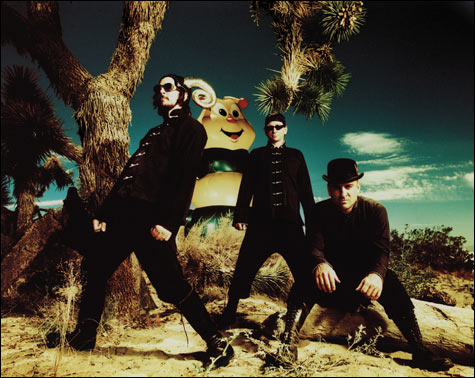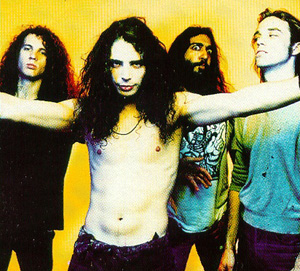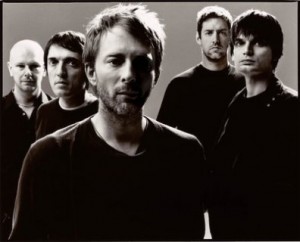
“In the Aeroplane Over the Sea,” “Holland, 1945”
Who Are They?
The king of indie bands (and carrot flowers).
For most casual ‘90s enthusiasts (those who own the odd compilation album and are aware of the existence of Nirvana), the name Neutral Milk Hotel doesn’t ring a bell. Not recognizing the name isn’t a criminal offense. I’m not gonna go all Pitchfork on your ass and berate your taste in music just because you’ve never heard “In the Aeroplane Over the Sea.” What I will do is give you the lowdown on the magic created by Jeff Mangum.
In the early ‘90s, Jeff began experimenting with music in the band The Olivia Tremor Control, and later recorded some of his own stuff under the name Milk. Neutral Milk Hotel began as just a recording project for Jeff as he wandered the country jobless, homeless and the epitome of the phrase “starving artist.”
It wasn’t until after the release of Everything Is (a 4-song EP) and On Avery Island that NMH became a full-fledged band. Before that, it was just Jeff and some other guys who happened to be hanging around. Julian Koster, Scott Spillane, and Jeremy Barnes joined the party as permanent members and work on the follow-up to Avery Island began in 1996.
The masterpiece In the Aeroplane Over the Sea was released in 1998 to high praise from critics and almost no response from the public (everyone must have been too busy listening to “My Heart Will Go On” for the millionth time).
Aeroplane definitely stood out with its inventive instrumentation (I’m pretty sure NMH is one of the only bands to use a singing saw) and passionate (albeit confusing) lyrics. As the legend goes, Jeff’s inspiration for the album stemmed from reading The Diary of Anne Frank. Although he has never confirmed that Aeroplane is all about her, it’s still a pretty popular theory.
Not even a year after the album’s release, Jeff became disenchanted with the music business (a plague that seems to haunt most ‘90s artists) and the band went on an indefinite hiatus. In a decidedly Cobain-esque move, Jeff went into hiding, only reemerging for the odd private show.

No longer a band, although Jeff keeps the memory alive.
While Jeff was in hiding, his bandmates started projects of their own. All three of them continue to release music under different names (Julian as The Music Tapes, Scott as The Gerbils, and Jeremy as A Hawk and a Hacksaw).
In 2005, In the Aeroplane Over the Sea was re-released by Domino Records and re-evaluated by critics. Pitchfork gave it an almost unheard of 10/10 rating. Can we just stop and take that in? That’s on par with Harry Potter riding a unicorn into Oz. This doesn’t happen every day, folks.
Jeff has become an infamous recluse for about a decade. He’s played a handful of private shows across the US, but no new recordings have surfaced.
But Why Neutral Milk Hotel?
Why, indeed? Well, Jeff Mangum is still alive. His latest appearance was at the All Tomorrow’s Parties Festival (yes, a festival) in the UK this past weekend. He also started a new website where he’s self-releasing a box set of Neutral Milk Hotel albums and unreleased tracks, but no new material as of right now.
Because the man is apparently an enigma (and cameras seem to be scarce at all his shows), I can only give you a taste of one of his live performances.
What Does Sam Think?
I’ll try my best to make this comprehensible (but I can’t make any promises).
I will admit that I have not been a Neutral Milk Hotel fan since the beginning. I had only heard the name mentioned by just about every music publication on the face of the earth. After some vigorous recommendations (or threats, rather) from friends, I finally gave this mysterious band a try.
And magic greeted my ears in the form of In the Aeroplane Over the Sea’s title track.
It’s very rare for me to immediately like a band upon first listen. It usually takes me a few tries to get into new music (see my love affair with Animal Colllective). However, NMH impressed me beyond reason.
So I’m sure you’re sitting here asking yourself, “What makes this band so damn special?” It’s difficult for me to give you a straight answer, so I’ll smash all my jumbled thoughts into this cliché expression: They’re so wrong, they’re right.
The distortion is almost oppressive, the horn section wavers in and out of tune, the lyrics make no sense, and Jeff’s voice leaves something to be desired. I don’t know if it’s sheer talent or just plain witchcraft, but all these seemingly atrocious qualities all work in the band’s favor.
If you forget everything you think you know about good music, you can hear the raw acoustics, the strange and subtle variation in instrumentation, and the pure emotions flowing from Jeff’s carefully constructed words.
I do acknowledge the fact that NMH isn’t for everyone. If you don’t like it, even after multiple attempts to like it, that doesn’t mean you have terrible taste in music. But once you “get” it, you’re hooked for life.
In the Aeroplane Over the Sea is a beautiful album (as is On Avery Island) and Jeff Mangum is truly an artist. And I’m not just saying that because I’m a Mangum fangirl (although that may be part of the reason).
Still not convinced this band belongs on “best of” lists all over the Internet? Consider this: without Jeff Mangum and Neutral Milk Hotel, you probably wouldn’t have Franz Ferdinand or Arcade Fire.
















 Sound Familiar?
Sound Familiar?
